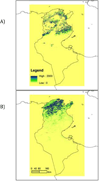Irrigation in the arid regions of Tunisia impacts the abundance and apparent density of sand fly vectors of Leishmania infantum
- PMID: 25447265
- PMCID: PMC4312219
- DOI: 10.1016/j.actatropica.2014.10.008
Irrigation in the arid regions of Tunisia impacts the abundance and apparent density of sand fly vectors of Leishmania infantum
Abstract
The distribution expansion of important human visceral leishmaniasis (HVL) and sporadic cutaneous leishmaniasis (SCL) vector species, Phlebotomus perfiliewi and P. perniciosus, throughout central Tunisia is a major public health concern. This study was designed to investigate if the expansion of irrigation influences the abundance of sand fly species potentially involved in the transmission of HVL and SCL located in arid bioclimatic regions. Geographic and remote sensing approaches were used to predict the density of visceral leishmaniasis vectors in Tunisia. Entomological investigations were performed in the governorate of Sidi Bouzid, located in the arid bioclimatic region of Tunisia. In 2012, sand flies were collected by CDC light traps located at nine irrigated and nine non-irrigated sites to determine species abundance. Eight species in two genera were collected. Among sand flies of the subgenus Larroussius, P. perfiliewi was the only species collected significantly more in irrigated areas. Trap data were then used to develop Poisson regression models to map the apparent density of important sand fly species as a function of different environmental covariates including climate and vegetation density. The density of P. perfiliewi is predicted to be moderately high in the arid regions. These results highlight that the abundance of P. perfiliewi is associated with the development of irrigated areas and suggests that the expansion of this species will continue to more arid areas of the country as irrigation sites continue to be developed in the region. The continued increase in irrigated areas in the Middle East and North Africa region deserves attention, as it is associated with the spread of L. infantum vector P. perfiliewi. Integrated vector management strategies targeting irrigation structures to reduce sand fly vector populations should be evaluated in light of these findings.
Keywords: Human visceral leishmaniasis; Integrated vector management; Phlebotomus perfiliewi; Remote sensing approaches.
Copyright © 2014 Elsevier B.V. All rights reserved.
Figures



Similar articles
-
Changes of Sand Fly Populations and Leishmania infantum Infection Rates in an Irrigated Village Located in Arid Central Tunisia.Int J Environ Res Public Health. 2016 Mar 16;13(3):329. doi: 10.3390/ijerph13030329. Int J Environ Res Public Health. 2016. PMID: 26999176 Free PMC article.
-
Co-circulation of Toscana virus and Leishmania infantum in a focus of zoonotic visceral leishmaniasis from Central Tunisia.Acta Trop. 2020 Apr;204:105342. doi: 10.1016/j.actatropica.2020.105342. Epub 2020 Jan 15. Acta Trop. 2020. PMID: 31954137
-
Phlebotominae (Diptera: Psychodidae) of human leishmaniosis sites in Tunisia.Parasite. 2006 Mar;13(1):23-33. doi: 10.1051/parasite/2006131023. Parasite. 2006. PMID: 16605064
-
The Sporadic cutaneous leishmaniasis due to Leishmania infantum in Morocco: A presumably trend towards endemicity.Acta Trop. 2022 Mar;227:106288. doi: 10.1016/j.actatropica.2021.106288. Epub 2021 Dec 20. Acta Trop. 2022. PMID: 34933005 Review.
-
[Monitoring of canine leishmaniasis in northern Italy: an update from a scientific network].Parassitologia. 2004 Jun;46(1-2):193-7. Parassitologia. 2004. PMID: 15305715 Review. Italian.
Cited by
-
Molecular detection and identification of Leishmania DNA and blood meal analysis in Phlebotomus (Larroussius) species.PLoS Negl Trop Dis. 2020 Mar 26;14(3):e0008077. doi: 10.1371/journal.pntd.0008077. eCollection 2020 Mar. PLoS Negl Trop Dis. 2020. PMID: 32214313 Free PMC article.
-
Changes of Sand Fly Populations and Leishmania infantum Infection Rates in an Irrigated Village Located in Arid Central Tunisia.Int J Environ Res Public Health. 2016 Mar 16;13(3):329. doi: 10.3390/ijerph13030329. Int J Environ Res Public Health. 2016. PMID: 26999176 Free PMC article.
-
Temporal dynamics and Leishmania infantum infection prevalence of Phlebotomus perniciosus (Diptera, Phlebotominae) in highly endemic areas of visceral leishmaniasis in Tunisia.PLoS One. 2017 Sep 21;12(9):e0184700. doi: 10.1371/journal.pone.0184700. eCollection 2017. PLoS One. 2017. PMID: 28934263 Free PMC article.
-
Canine leishmaniosis in Tunisia: Growing prevalence, larger zones of infection.PLoS Negl Trop Dis. 2021 Dec 10;15(12):e0009990. doi: 10.1371/journal.pntd.0009990. eCollection 2021 Dec. PLoS Negl Trop Dis. 2021. PMID: 34890393 Free PMC article.
-
Diversity, Abundance and Leishmania infantum Infection Rate of Phlebotomine Sandflies in an Area with Low Incidence of Visceral Leishmaniasis in Northern Tunisia.Microorganisms. 2022 May 11;10(5):1012. doi: 10.3390/microorganisms10051012. Microorganisms. 2022. PMID: 35630455 Free PMC article.
References
-
- World Health Organization (WHO) Urbanization: An increasing risk factor for Leishmaniasis. Wkly. Epidemiol. Record. 2002;77:365–372. - PubMed
-
- World Health Organization (WHO) Report of the Consultative Meeting on Cutaneous Leishmaniasis. 2008 www.who.int/leishmaniasis/resources/Cutaneous_leish_cm_2008.pdf)
-
- Abonnenc E. Les phlébotomes de la région éthiopienne (Diptera, Psychodidae) Mémoires de l’ORSTOM. 1972;55:289.
-
- Anderson C. Chronique du kala azar. Arch. Inst. Pasteur Tunis. 1938;27:97–104.
Publication types
MeSH terms
Grants and funding
LinkOut - more resources
Full Text Sources
Other Literature Sources
Research Materials
Miscellaneous

